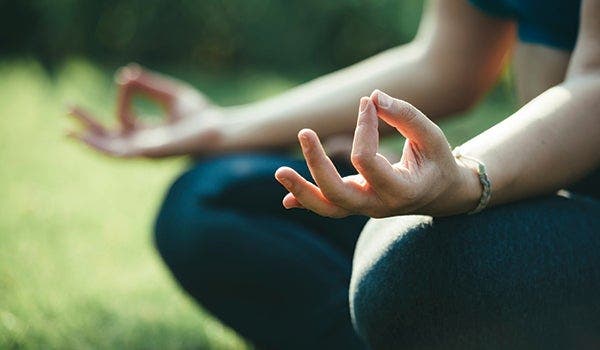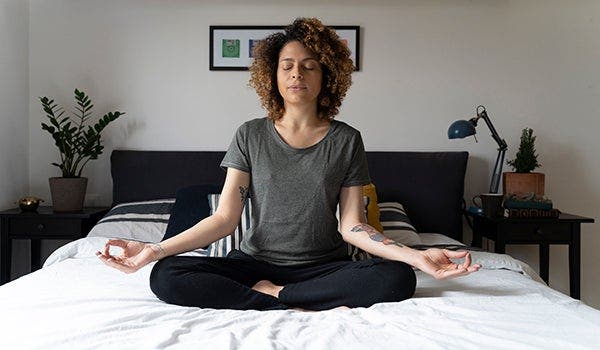How to meditate: A beginner’s guide to meditation


First things first: You don’t need to be an ultra enlightened yogi to learn how to meditate. This mind-body practice - which encompasses a variety of techniques aimed at cultivating focused, nonjudgmental self-awareness - is more approachable than you might think. What’s more, meditation may even improve your health.
“Over the past decade, there’s been a tremendous increase in the amount and quality of research about its potential role in health and wellbeing,” says Dr. Rashmi Bismark, MD, MPH, a physician specializing in preventative health and a certified yoga instructor based in the island territory of Jersey.
Rooted in traditions thousands of years old, including Ayurvedic practices and Buddhism, meditation gets its modern-day staying power in part from being broadly accessible, says Dr. Gregory Brown, MD, a psychiatrist, certified yoga teacher, and spokesperson for the American Psychiatric Association. “Meditation is available to anyone regardless of age, physical condition, gender, or ethnic background,” he says.
Read on for a helpful guide to popular forms of meditation, advice on meditation for beginners, and a closer look at the potential health benefits of meditation, from improved sleep to reduced stress.
Meditation 101: The basics for beginners

If you’re new to meditation, you might be more familiar with the concept of mindfulness: an awareness of thoughts, feelings, and sensations in the present moment, without value judgments. You can practice mindfulness in pretty much any situation - while eating breakfast with your family, while brushing your teeth, while inching along in rush-hour traffic... You get the idea.
Meditation touches on a lot of that thinking but is generally a more intentional act - something you do in a quiet setting during time you’ve set aside for that purpose, according to the NCCIH. Think of it as a form of training: you learn to continuously bring your attention back to the present to help develop a greater sense of focused calm and awareness in your everyday life.
Meditation techniques are numerous - some call for being seated, while others call for lying down, standing, or even moving. According to Dr. Bismark, the common thread is that with regular practice, meditation can help dial back the brain’s tendency to activate the sympathetic nervous system, which governs the body’s “fight or flight” responses to perceived stressors or threats. Later in this article, we’ll take a deeper dive into the research on meditation. First, here’s a bit more on different techniques.
Mindfulness meditation
The goal of mindfulness meditation is to practice being fully in the now. "It's about remaining connected to your presence and open to receiving incoming experiences or sensations," Dr. Bismark explains. Approaches to mindfulness meditation vary - some people focus on their breath; others may follow a body scan exercise to ground themselves in the moment. The goal is to feel present in a spirit of equanimity, without reflecting on the past or speculating about the future. With regular practice, Dr. Bismark says, mindfulness meditation can help people become more aware and appreciative of everyday experiences, such as tasting food and spending time in nature.
Other types of meditation
There’s no one perfect way to meditate. Here are some other widely used approaches and techniques.
Concentration meditation
Concentration meditation involves training the mind to focus on a single point, such as a mantra (a word or number of personal significance), an image, or a physical sensation such as breath, Dr. Bismark explains. Some people practice concentration meditation as a prelude to mindfulness meditation.
Loving kindness meditation
Loving kindness meditation is a concentration practice that involves mentally directing benevolence toward yourself and others, often by repeating a phrase or recalling a memory that evokes a sense of connection, compassion, and forgiveness. Such thoughts can carry through in everyday life to deepen and enrich relationships, Dr. Bismark says.
Guided meditation
Guided meditation is any meditation practice that’s led by another person, whether in a group, one on one, or through a virtual channel such as audio track or podcast. Guided sessions are available for a range of meditative disciplines and can be helpful if you're new to meditation and unsure of where to start. Still, even experienced practitioners stand to gain from guided meditation, Dr. Bismark says. “The benefit may be insights that trigger greater awareness in yourself.”
Zen meditation
Zen meditation is rooted in Buddhist spiritual practices, though it’s also popular in secular circles. Zen meditation often calls for a specific posture: sitting cross-legged in a lotus or half-lotus position with palms pressed together at the lower abdomen, chin tilted downward, mouth closed, and gaze loosely directed forward. The general objective is to achieve a state of self-awareness and insight without focusing on any particular thought or mantra.
Transcendental Meditation
Transcendental Meditation, also known as TM, is a technique that was developed by Maharishi Mahesh Yogi (1918–2008), a spiritual advisor known for his work with The Beatles. TM is centered on repeated mantras - words, sounds, or phrases - with an aim of helping the mind transcend surface-level awareness to find a “deep inner silence.” Maharishi Foundation USA, which certifies TM classes and instructors, recommends practicing for 20 minutes twice a day.
Moving meditation: Yoga, tai chi, and qigong
Yoga, tai chi, and qigong all involve movement with focused, meditative intent, Dr. Bismark explains. Yoga is a series of postures and breathing exercises commonly practiced to increase flexibility, physical strength, and relaxation; qigong is a centuries-old practice that combines physical movement, breathwork, and meditation to promote healing and balance; and tai chi is a related form of moving meditation and also a martial art. These might be good practices to explore if you’re looking for an extra dose of inner calm with your workouts, Dr. Brown says.
Benefits of meditation: What the science says

Despite having existed for millennia, meditation remains an active area of study. Due to limitations of early research - such as small sample sizes and lack of control groups for comparison - rigorous investigation is still needed for us to fully understand the potential health impacts of meditation, according to a 2017 article in the journal Perspectives on Psychological Science. Here are some areas researchers are exploring.
Stress
Growing evidence supports the idea that meditation can have a calming effect on the body, according to a 2017 meta-analysis of 45 randomized controlled trials published in the Journal of Psychiatric Research. Across diverse populations, regular mediation practice was associated with reductions in physiological markers of stress, such as the hormone cortisol.
Anxiety
In a 2014 of review of 47 studies involving 3,515 adults, eight weeks of regular meditation was associated with moderate improvements in symptoms of anxiety and depression. The findings add to those of a 2012 meta-analysis of 36 studies, which suggested that meditation may be an option for managing anxiety symptoms. If you live with anxiety or depression and want to try meditation, Dr. Bismark suggests asking your doctor or therapist for guidance on incorporating the practice into your overall care plan.
Eating patterns
Mindfulness meditation may be helpful for managing unhealthy patterns of eating, such as binge eating and emotional eating, a 2014 review of 14 studies found. (In that analysis, results were mixed concerning the potential effects of meditation on weight loss.) This is another case where it’s a good idea to get your doctor’s input on whether meditation might be helpful to you, Dr. Bismark says.
Cognitive function
Some preliminary evidence suggests that meditation may be good for the brain. In a small 2018 study, volunteers who listened to a 10-minute, guided mindfulness meditation exercise performed better on computer tasks afterward than volunteers who listened to a 10-minute science lecture. As for long-term brain health, a 2014 systematic review outlined in The Journal of Alzheimer’s Disease suggests that regular meditation may help counter the atrophying of gray matter associated with some neurodegenerative diseases.
Sleep
In a small 2014 study conducted by the National Institutes of Health, adults with chronic insomnia who practiced mindfulness meditation felt less keyed up at bedtime and experienced fewer waking minutes overnight than volunteers who didn’t meditate. Another small study, this one involving 49 older adults who were experiencing regular sleep trouble, reinforces those findings: Volunteers who followed a 6-week meditation program saw stronger improvements in sleep quality and daytime fatigue than those who took a 6-week class on sleep hygiene.
Pain
In a 2020 meta-analysis of studies involving 6,404 volunteers taking opioid medications for pain, meditation was one of several mind-body therapies linked with a moderate to strong reduction in pain symptoms. (Cognitive behavioral therapy was another.) The findings were published in the journal JAMA Internal Medicine.
Compassion
Meditation practices that are developed to elicit goodwill—such as the loving kindness technique described earlier in this article—may boost positive emotions and make people feel more compassionate toward others and themselves, according to a 2014 meta-analysis of 22 studies.
How do you meditate?
Opportunities abound for learning how to meditate. Options include in-person classes, meditation retreats, and meditation apps offering guided audio meditations. (The popular app Headspace is available to WW members in the WW app.) Feel free to explore and see what resonates with you, Dr. Brown says. The goal is to find an approach that you feel comfortable practicing regularly.
Learn a simple meditation exercise
Want to try meditating? Dr. Brown recommends the following basic meditation for beginners and experienced practitioners alike:
- Pick a resting position. Find a position that’s comfortable and allows you to relax and focus. Some people like to sit cross-legged on the floor; others prefer to lie back on a bed or mat. Whatever feels right for you is fine for this exercise.
- Decide on a time limit. Set a countdown timer before you begin so you don’t spend the meditation wondering, “Have I done this long enough yet?” Even one minute might be enough for you to feel a positive effect, says Dr. Brown: “When I introduce people to this, after 60 seconds of breathwork everyone tells me they feel so much better and calmer.” Feel free to go longer if you like—five minutes, 10 minutes, or more.
- Note your feelings. Do you feel anxious? Tired? Happy? Neutral? There are no wrong answers; meditation can happen no matter what your state of mind. Simply observe your feelings without judgment and allow yourself to be with them as you begin.
- Pace your breath. For this exercise, Dr. Brown recommends a technique called 4-7-8 breathing: Breathe in for a count of four seconds, hold your breath for a count of seven, and exhale slowly for a count of eight. This acts as a focusing tool that directs the mind to the present moment and simultaneously calms the body, he says.
- Be kind to your mind. Meditation isn’t about controlling or squashing your thoughts; it’s about training your attention (like you would a muscle!). If you find yourself momentarily distracted by memories of an argument you had last week or worries about next week’s big work meeting, don’t be hard on yourself. Wandering thoughts are normal, Dr. Brown says. To help yourself stay present, try imagining those thoughts floating past like clouds in the sky.
- Close with self-gratitude. As your meditation session comes to a close, reinforce that spirit of self-compassion by thanking yourself for taking the time to meditate. Then carry that mentality forward through the rest of your day. Congrats, you’ve just meditated!
The upshot: Are you ready to start meditating?
If you want to start meditating, you’re ready! Meditation can be a helpful tool for coping with daily stress and the overstimulation of a hectic world. Some research suggests it may also benefit long-term health. Meditation techniques vary - there’s no “perfect” way to meditate, experts say. Use that freedom and flexibility to develop a meditation practice that works for your lifestyle.
